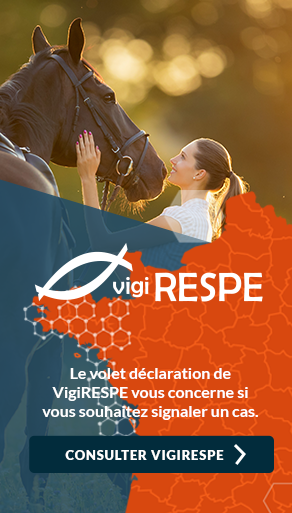![[Appel à vigilance] Foyers de rhinopneumonie (HVE1)](https://respe.net/wp-content/uploads/2021/02/fei-150x150.png)
[Appel à vigilance] Foyers de rhinopneumonie (HVE1)
Des cas de rhinopneumonie (HVE1) viennent d’être confirmés ce jour en Espagne, par tests PCR.
Une partie de cet effectif ayant pour destination la France, nous vous relayons la communication faite à ce sujet par la FEI :
Equine Herpes Virus (EHV) is found in many parts of the world and cases and outbreaks can be seen at any time of year. Certain strains of the virus can cause severe illness in horses, which can result in their stables being placed under quarantine for several weeks so that horses cannot travel and are unable to compete.
Equine Herpes Virus is a contagious disease that affects horses. Although there are nine strains of the virus, Equine Herpes Virus-1 (EHV-1) and Equine Herpes Virus-4 (EHV-4) are most commonly seen. Affected horses may suffer respiratory disease, neurological disease and abortion in pregnant mares. Young foals are also at risk and can die from the infection.How is the disease transmitted?
The Equine Herpes Virus can be transferred through the air from horse to horse up to distances of 5 metres. Horses can become infected and bring the disease to their home stables and transmit the virus to other horses through close contact and coughing. The virus can also be transmitted on clothing and yard equipment by people working with infected horses.Horse transport is also a risk for disease transmission. Lorries and trailers in which infected horses have travelled may be contaminated with the virus and transmit the disease to others. Thorough cleaning of all equine transport vehicles must be carried out between shipments. Stables must be thoroughly cleaned and disinfected between horses.What clinical signs should I look out for?
The clinical signs of Equine Herpes Virus depend on the strain of the virus affecting the horse.Horses suffering from EHV-1 can develop a fever, respiratory disease such as coughing and clear nasal discharge. Some horses may develop neurological signs leading to lack of coordination, weakness, difficulty in urinating and defecating and becoming recumbent (unable to stand up). Horses that are severely affected by the neurological form of the disease may have to be euthanised. The virus is also a common cause of abortion in pregnant mares and the death of young foals.EHV-4 infections commonly result in horses developing a fever, cough and clear nasal discharge. The virus can also cause abortion in pregnant mares, but this is less commonly seen.
Infected horses can develop complications such as secondary bacterial infections.
I suspect my horse has the Equine Herpes Virus. What should I do?
Horses showing the early signs of the disease must be isolated and examined by a veterinarian. Clinical signs are often seen within approximately 10 days of being in contact with the virus. Since infected horses can show similar clinical signs to other diseases, your veterinarian should take nasopharyngeal swabs and blood samples for laboratory analysis in order to confirm the diagnosis.
Horses that have been in-contact with the affected horse must be identified, isolated and tested for the disease. The movement of all horses on and off the affected stables site must be restricted and strict biosecurity measures enforced. The measures include foot baths, hand disinfection and the prevention of equipment sharing.
How quickly do horses recover?
Recovery rates from Equine Herpes Virus are variable. It depends on the severity of the clinical signs and whether the horse has suffered secondary infections.
What is the period of time that movements must be restricted?
The restriction of movement can be in place for many weeks. Unlike Equine Influenza which is transmitted between horses quickly, there is a slower transmission time for the Equine Herpes Virus. Additionally, horses may not immediately display signs of the disease. It is necessary to test horses for EHV at intervals of several weeks to ensure that all affected horses and any in-contact horses have tested negative before horse movements can resume.
How can I protect my horses?
A vaccine against EHV-1 and EHV-4 is available but does not protect the horse against the neurological form of the disease. However, the use of the vaccine can help to reduce the shedding of the virus, its transmission to other horses and the severity of the respiratory form of the disease. The vaccine should not be used during an outbreak at stables. Your veterinarian will be able to advise you further on the use of the vaccine.
The FEI recommends that horses which have mixed with others are closely monitored on their return home and their rectal temperature taken twice daily. Horses that have a fever must be examined by a veterinarian as soon as possible.
Where horses have travelled away from their home stables, strict hygiene measures should be carried out at the home stables to reduce the transmission of the virus to other horses. It is important to make sure that horses do not share equipment such as water buckets/troughs, feed bowls, tack and grooming equipment, and that anyone working with horses washes their hands between handling horses. All vehicles used for transportation must be thoroughly cleaned between horses.
A horse displaying any signs of illness should be isolated, not leave their home yard and be examined by a veterinarian. This also applies to any horse that has been in contact with a horse or horses that have the Equine Herpes Virus.
Lien vers le site de la FEI : https://www.fei.org/

